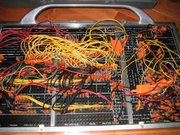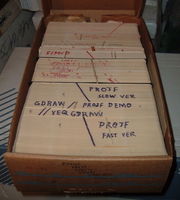Computer programmingFrom Wikipedia, the free encyclopediaComputer programming (often shortened to programming or coding) is the process of writing, testing, debugging/troubleshooting, and maintaining the source code of computer programs. The source code is written in a programming language. This code may be a modification of an existing source or something completely new, the purpose being to create a program that exhibits the desired behavior (customization). The process of writing source codes requires expertise in many different subjects, including knowledge of the application domain, specialized algorithms, and formal logic. Within software engineering, programming (the implementation) is regarded as one phase in a software development process. In some specialist applications or extreme situations a program may be written or modified (known as patching) by directly storing the numeric values of the machine code instructions to be executed into memory. There is an ongoing debate on the extent to which the writing of programs is an art, a craft or an engineering discipline. Good programming is generally considered to be the measured application of all three, with the goal of producing an efficient and maintainable software solution (the criteria for "efficient" and "maintainable" vary considerably). The discipline differs from many other technical professions in that programmers generally do not need to be licensed or pass any standardized (or governmentally regulated) certification tests in order to call themselves "programmers" or even "software engineers". Another ongoing debate is the extent to which the programming language used in writing programs affects the form that the final program takes. This debate is analogous to that surrounding the Sapir-Whorf hypothesis in linguistics.[citation needed]
Programmers
Computer programmers are those who write computer software. Their job usually involves:
Programming languagesDifferent programming languages support different styles of programming (called programming paradigms). The choice of language used is subject to many considerations, such as company policy, suitability to task, availability of third-party packages, or individual preference. Ideally, the programming language best suited for the task at hand will be selected. Trade-offs from this ideal involve finding enough programmers who know the language to build a team, the availability of compilers for that language, and the efficiency with which programs written in a given language execute. Allen Downey, in his book "How To Think Like A Computer Scientist" [1]wrote:
History of programmingThe earliest programmable machine (that is a machine whose behavior can be controlled by changes to a "program") was Al-Jazari's programmable humanoid robot in 1206. Al-Jazari's robot was originally a boat with four automatic musicians that floated on a lake to entertain guests at royal drinking parties. His mechanism had a programmable drum machine with pegs (cams) that bump into little levers that operate the percussion. The drummer could be made to play different rhythms and different drum patterns by moving the pegs to different locations. The Jacquard Loom, developed in 1801, is often quoted as a source of prior art. The machine used a series of pasteboard cards with holes punched in them. The hole pattern represented the pattern that the loom had to follow in weaving cloth. The loom could produce entirely different weaves using different sets of cards. The use of punched cards was also adopted by Charles Babbage around 1830, to control his Analytical Engine. This innovation was later refined by Herman Hollerith who, in 1896 founded the Tabulating Machine Company (which became IBM). He invented the Hollerith punched card, the card reader, and the key punch machine. These inventions were the foundation of the modern information processing industry. The addition of a plug-board to his 1906 Type I Tabulator allowed it to do different jobs without having to be rebuilt (the first step toward programming). By the late 1940s there were a variety of plug-board programmable machines, called unit record equipment, to perform data processing tasks (card reading). The early computers were also programmed using plug-boards. The invention of the Von Neumann architecture allowed programs to be stored in computer memory. Early programs had to be painstakingly crafted using the instructions of the particular machine, often in binary notation. Every model of computer would be likely to need different instructions to do the same task. Later assembly languages were developed that let the programmer specify each instruction in a text format, entering abbreviations for each operation code instead of a number and specifying addresses in symbolic form (e.g. ADD X, TOTAL). In 1954 Fortran, the first higher level programming language, was invented. This allowed programmers to specify calculations by entering a formula directly (e.g. Y = X*2 + 5*X + 9). The program text, or source, was converted into machine instructions using a special program called a compiler. Many other languages were developed, including ones for commercial programming, such as COBOL. Programs were mostly still entered using punch cards or paper tape. (See computer programming in the punch card era). By the late-60s, data storage devices and computer terminals became inexpensive enough so programs could be created by typing directly into the computers. Text editors were developed that allowed changes and corrections to be made much more easily than with punch cards. As time has progressed computers have made giant leaps in the area of processing power. This has brought about newer programming languages that are more abstracted from the underlying hardware. Although these more abstracted languages require additional overhead, in most cases the huge increase in speed of modern computers has brought about little performance decrease compared to earlier counterparts. The benefits of these more abstracted languages is that they allow both an easier learning curve for people less familiar with the older lower-level programming languages, and they also allow a more experienced programmer to develop simple applications quickly. Despite these benefits, large complicated programs, and programs that are more dependent on speed still require the faster and relatively lower-level languages with todays hardware. (The same concerns were raised about the original Fortran language.) Throughout the second half of the twentieth century, programming was an attractive career in most developed countries. Some forms of programming have been increasingly subject to offshore outsourcing (importing software and services from other countries, usually at a lower wage), making programming career decisions in developed countries more complicated, while increasing economic opportunities in less developed areas. It is unclear how far this trend will continue and how deeply it will impact programmer wages and opportunities. Despite the "outsourcing trend" it can be argued that some of the richest persons on the globe are programmers by profession. Examples: Larry Page and Sergey Brin (Google), Steve Wozniak (Apple Inc.), Hasso Plattner (SAP) and so on. Programming is clearly a leading-edge craftsmanship that continues to reward its practitioners not only in developed countries but also in rapidly developing countries like India. Modern programmingQuality requirementsWhatever be the approach to the software development, the program must finally satisfy some fundamental properties; bearing them in mind while programming reduces the costs in terms of time and/or money due to debugging, further development and user support. Although quality programming can be achieved in a number of ways, following five properties are among the most relevant:
Algorithmic ComplexityThe academic field and engineering practice of computer programming are largely concerned with discovering and implementing the most efficient algorithms for a given class of problem. For this purpose, algorithms are classified into orders using so-called Big O notation, O(n), which expresses resource use, such as execution time and memory consumption, in terms of the size of an input. Expert programmers are familiar with a variety of well-established algorithms and their respective complexities and use this knowledge to choose algorithms that are best suited to their circumstances. Research in computer programming includes investigation into the unsolved proposition that P, the class of algorithms which can be deterministically solved in polynomial time with respect to an input, is not equal to NP, the class of algorithms for which no polynomial-time solutions are known. Work has shown that many NP algorithms can be transformed, in polynomial time, into others, such as the Travelling salesman problem, thus establishing a large class of "hard" problems which are for the purposes of analysis, equivalent. MethodologiesThe first step in every software development project should be requirements analysis, followed by modeling, implementation, and failure elimination (debugging). There exist a lot of differing approaches for each of those tasks. One approach popular for requirements analysis is Use Case analysis. Popular modeling techniques include Object-Oriented Analysis and Design (OOAD) and Model-Driven Architecture (MDA). The Unified Modeling Language (UML) is a notation used for both OOAD and MDA. A similar technique used for database design is Entity-Relationship Modeling (ER Modeling). Implementation techniques include imperative languages (object-oriented or procedural), functional languages, and logic languages. Debugging is most often done with IDEs like Visual Studio, NetBeans, and Eclipse. Separate debuggers like gdb are also used. Measuring language usageIt is very difficult to determine what are the most popular of modern programming languages. Some languages are very popular for particular kinds of applications (e.g., COBOL is still strong in the corporate data center, often on large mainframes, FORTRAN in engineering applications, and C in embedded applications), while some languages are regularly used to write many different kinds of applications. Methods of measuring language popularity include: counting the number of job advertisements that mention the language, the number of books teaching the language that are sold (this overestimates the importance of newer languages), and estimates of the number of existing lines of code written in the language (this underestimates the number of users of business languages such as COBOL). DebuggingDebugging is a very important task for every programmer, because an erroneous program is often useless. Languages like C++ and Assembler are very challenging even to expert programmers because of failure modes like buffer overruns, bad pointers or uninitialized memory. A buffer overrun can damage adjacent memory regions and cause a failure in a totally different program line. Because of those memory issues tools like Valgrind, Purify or Boundschecker are virtually a necessity for modern software development in the C++ language. Languages such as Java, C#, PHP and Python protect the programmer from most of these runtime failure modes, but this may come at the price of a dramatically lower execution speed of the resulting program. This is acceptable for applications where execution speed is determined by other considerations such as database access or file I/O. The exact cost will depend upon specific implementation details. Modern Java virtual machines and .NET Common Language Runtime, for example, use a variety of sophisticated optimizations, including runtime conversion of interpreted instructions to native machine code. |

 Implementation
Implementation
